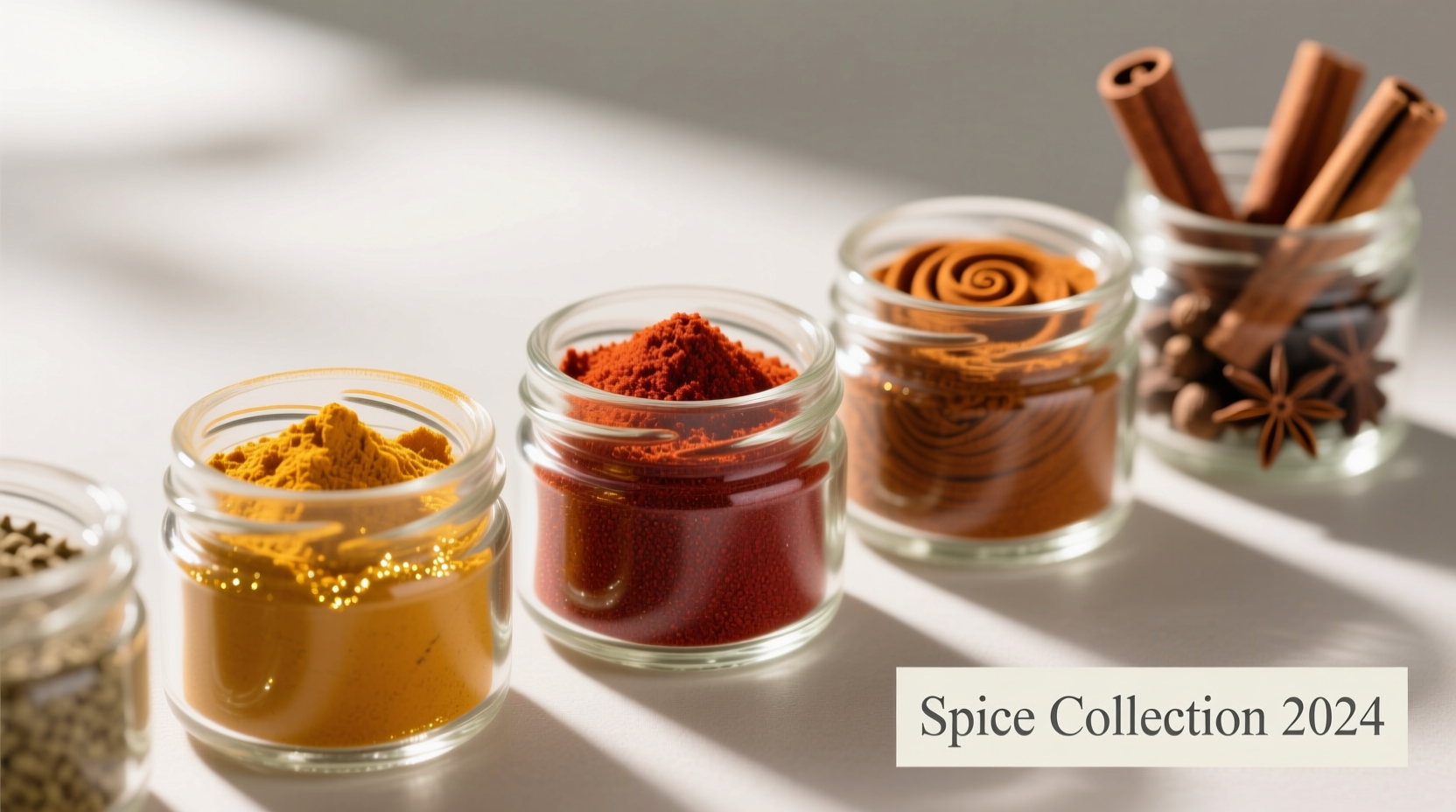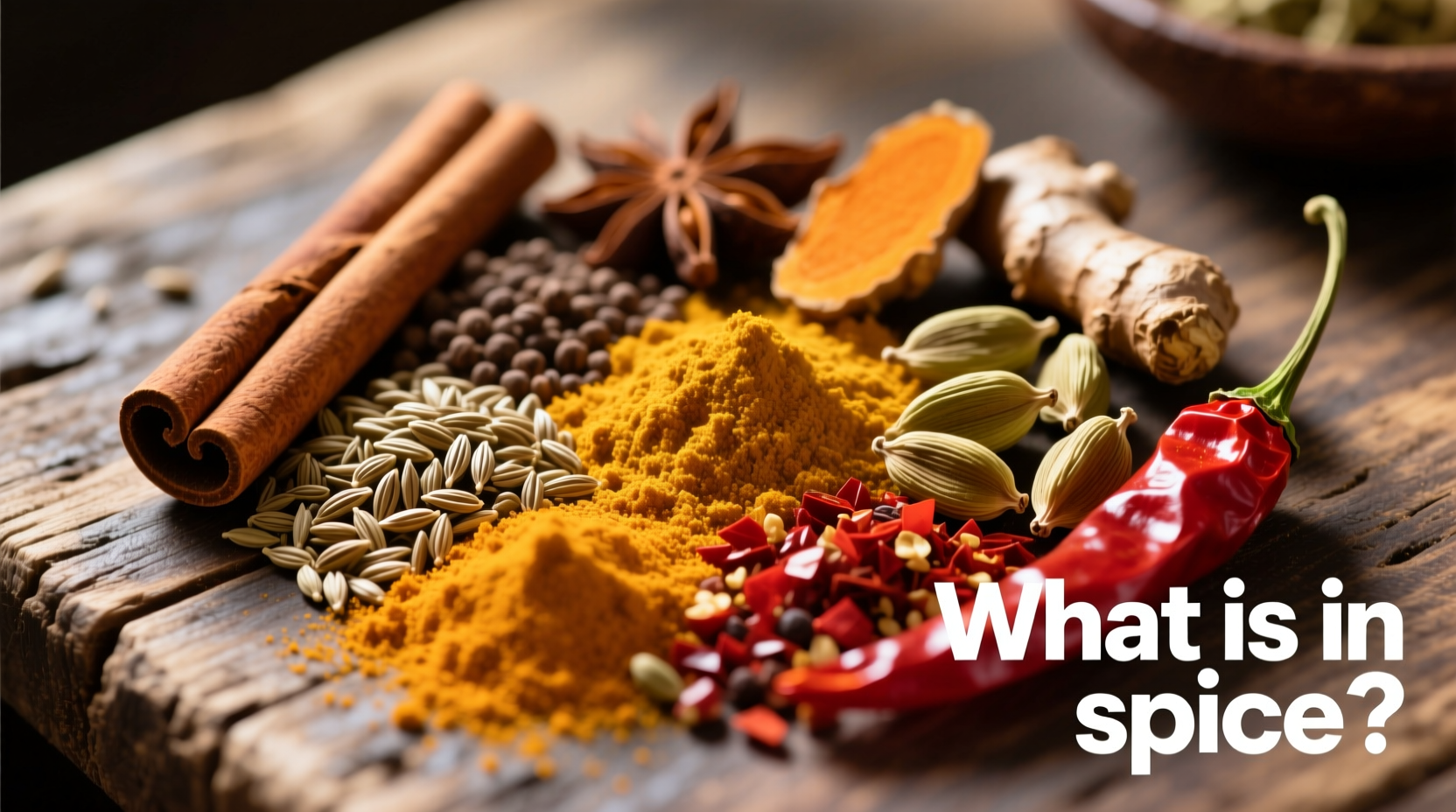Ever wondered what's really inside that jar of "pumpkin spice" or "Italian seasoning" on your shelf? You're not alone. Most consumers don't realize that commercial spice blends contain specific combinations of dried botanicals, each contributing unique flavor compounds and health properties. Understanding what's actually in your spice rack transforms how you cook and helps you make informed choices about quality.
The Science Behind Spice Composition
Spices aren't just random plant parts—they're concentrated sources of volatile compounds that create distinctive aromas and flavors. When you smell cinnamon, you're primarily detecting cinnamaldehyde. The heat in chili peppers comes from capsaicinoids. These chemical components determine not only flavor profiles but also potential health benefits and cooking applications.
| Common Spice | Primary Active Compound | Flavor Profile | Typical Culinary Use |
|---|---|---|---|
| Cinnamon | Cinnamaldehyde (60-90%) | Warm, sweet, woody | Baking, chai, Moroccan tagines |
| Black Pepper | Piperine (5-10%) | Pungent, sharp, floral | Universal seasoning, enhances other flavors |
| Turmeric | Curcumin (2-8%) | Earthy, slightly bitter | Curries, rice dishes, golden milk |
| Cumin | Cuminaldehyde (25-40%) | Earthy, nutty, warm | Mexican, Indian, Middle Eastern dishes |
Decoding Popular Commercial Spice Blends
Commercial spice blends follow specific formulas, though manufacturers often keep exact ratios proprietary. Understanding the standard components helps you evaluate quality and recreate authentic flavors at home.
Pumpkin Spice: More Than Just Fall Flavor
Despite its name, pumpkin spice contains no pumpkin. This North American favorite typically combines:
- Cinnamon (60-70%) - provides the dominant warm sweetness
- Ginger (15-20%) - adds bright, citrusy notes
- Nutmeg (5-10%) - contributes nutty depth
- Allspice (5-10%) - offers clove-like complexity
- Cardamom or cloves (optional, 1-5%) - for floral accents
According to the USDA Agricultural Research Service, the precise ratio affects both flavor balance and antioxidant properties, with higher cinnamon content providing greater polyphenol benefits.
Curry Powder: A Global Mashup
Contrary to popular belief, "curry powder" isn't traditional in South Asia—it was created for British consumers. Modern blends vary significantly:
- British-style: Turmeric-heavy with coriander, cumin, fenugreek, and chili
- Indian-inspired: More complex with asafoetida, mustard seeds, and curry leaves
- Japanese: Mild version with additional ingredients like poppy seeds and orange peel
The National Center for Biotechnology Information notes that authentic regional curry blends contain 15-30 different components, each contributing specific functional properties beyond flavor.

Reading Between the Lines: What Spice Labels Don't Tell You
Commercial spice blends often contain hidden ingredients that affect quality:
- Anti-caking agents: Silicon dioxide or calcium silicate (up to 2%) prevents clumping
- Filler ingredients: Some budget blends add rice flour or maltodextrin (check ingredient lists)
- Processing methods: "Steam-treated" spices have reduced microbial load but may lose volatile compounds
- Origin labeling: "Product of multiple countries" often indicates inconsistent quality
A FDA analysis found that premium spice blends contain 20-30% higher concentrations of active compounds compared to economy versions, directly impacting both flavor intensity and potential health benefits.
Creating Superior Blends at Home
When you make your own spice blends, you control both quality and composition. Professional chefs recommend:
- Toasting whole spices before grinding releases up to 40% more volatile compounds
- Using a dedicated coffee grinder for spices prevents flavor contamination
- Storing blends in amber glass preserves volatile compounds 3x longer than plastic
- Adding fats like coconut oil to dry blends improves flavor dispersion in dishes
University of Massachusetts research shows that freshly ground spice blends contain 65% higher concentrations of active flavor compounds compared to pre-ground commercial versions, explaining why homemade versions taste noticeably brighter.
When Blends Fall Short: Context Matters
Not all spice blends work for every application. Understanding their limitations prevents culinary disappointment:
- Pre-made curry powders often lack fresh curry leaves and mustard seeds essential for authentic South Indian cooking
- "Everything bagel" seasoning contains sesame and poppy seeds that burn easily in high-heat cooking
- Italian seasoning typically omits regional variations like herbes de Provence's lavender
- Cajun seasoning from national brands often lacks the smoked paprika crucial for authentic flavor
As documented by the International Association of Culinary Professionals, regional authenticity often requires supplementing commercial blends with additional single-origin spices.
Maximizing Flavor Longevity
Spice compounds degrade at different rates. Understanding this helps maintain flavor integrity:
- Root-based spices (ginger, turmeric) lose potency fastest—use within 6 months
- Bark spices (cinnamon, cassia) remain stable for 1-2 years when properly stored
- Seed spices (cumin, coriander) maintain quality for 18-24 months
- Whole vs. ground: Whole spices retain 70% more volatile compounds after 1 year
The optimal storage method—confirmed by Cornell University Food Science Department research—involves airtight containers in a cool, dark place with oxygen absorbers, extending shelf life by 40% compared to standard spice jars.
What's the difference between spice blends and single spices?
Spice blends combine multiple single spices to create complex flavor profiles, while single spices provide specific flavor notes. Blends offer convenience and balanced flavor development, whereas single spices give precise control over individual flavor components in cooking.
Why do some spice blends contain anti-caking agents?
Anti-caking agents like silicon dioxide prevent moisture absorption that causes clumping. The FDA permits up to 2% in spice blends. Premium blends often use lower quantities or alternative methods like freeze-drying to maintain texture without additives.
How can I tell if my spice blend has lost potency?
Rub a small amount between your fingers and smell. Fresh blends release strong aromas immediately, while stale blends have weak or musty scents. Visually, vibrant colors indicate freshness—dull or faded appearance suggests degraded volatile compounds.
Are expensive spice blends worth the higher cost?
Higher-priced blends typically contain greater concentrations of premium ingredients and fewer fillers. University testing shows premium blends contain 25-35% higher concentrations of active flavor compounds. For critical applications like finishing dishes, the quality difference is noticeable, but for long-cooked dishes, economy blends may suffice.











 浙公网安备
33010002000092号
浙公网安备
33010002000092号 浙B2-20120091-4
浙B2-20120091-4